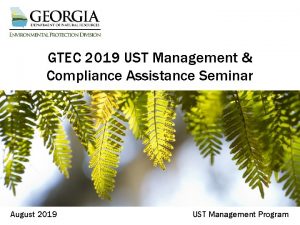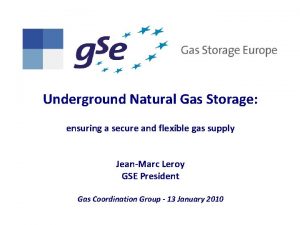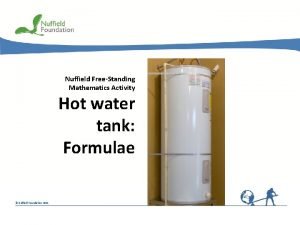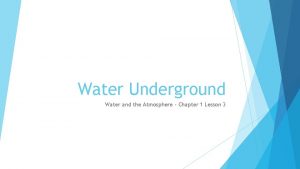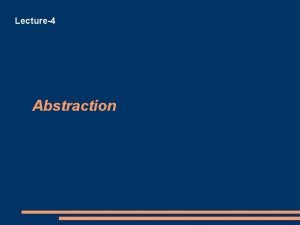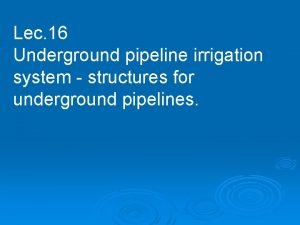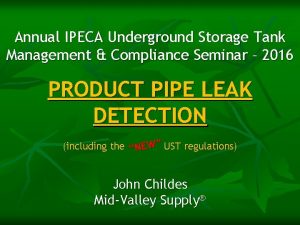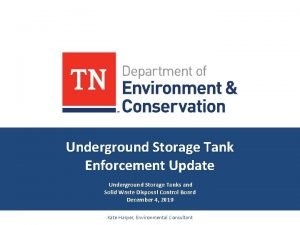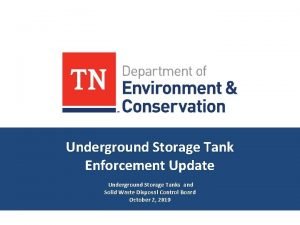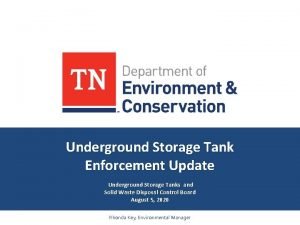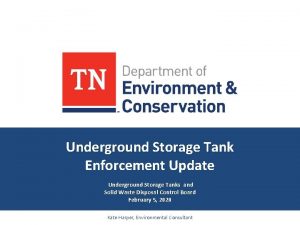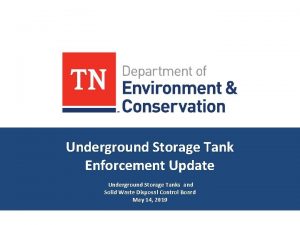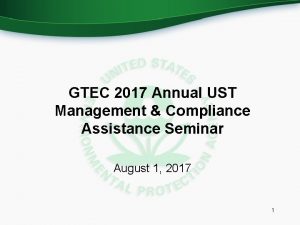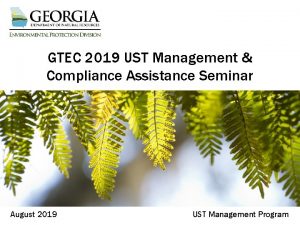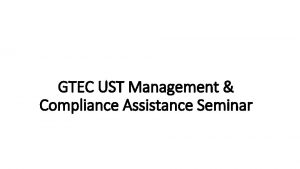Annual GTEC Underground Storage Tank Management Compliance Seminar














- Slides: 14

Annual GTEC Underground Storage Tank Management & Compliance Seminar – 2019 RELEASE DETECTION TESTING REQUIREMENTS (including the ‘new 2020’ UST regulations) Katie Seaborn AMERICAN CONTAINMENT SERVICES, INC. ®

Georgia Rule 391 -3 -15 -. 07 “Release Detection” incorporates by reference 40 CFR Part 280, Subpart D: § 280. 40 – General Requirements for all UST systems. § 280. 41 – Requirements for petroleum UST systems. § 280. 42 – Requirements for hazardous substance UST systems. § 280. 43 - Methods of release detection for tanks. § 280. 44 - Methods of release detection for piping. § 280. 45 – Release detection recordkeeping.

§ 280. 40 – General requirements for all UST systems. Each UST System MUST have a method, or combination of methods, of release detection that: 1. can detect a release from any portion of the UST and underground piping that routinely contains product; 2. is installed and calibrated per the manufacturer's instructions; 3. is operated, maintained, and tested for properation not less than annually* * COMPLIANCE BY OR BEFORE DECEMBER 15, 2020!

§ 280. 40 – General requirements for all UST systems. 4. Release detection (a. k. a. leak detection) methods must meet the performance standards outlined in § 280. 40(a)(4). (a) If a release is indicated or detected –> EPD must be notified within 24 -hours, and the steps outlined in Subpart E are to be followed. (b) UST systems that cannot comply with § 280. 40 must be closed per Subpart G. * * COMPLIANCE BY OR BEFORE DECEMBER 15, 2020!

Methods of Release Detection THE VARIOUS RELEASE DETECTION METHODS CAN BE SORTED INTO THREE CATEGORIES: 1. Interstitial Method 2. Internal Methods 3. External Methods

§ 280. 43 – Methods of release detection for tanks. Ø Interstitial Method l l l Monitoring and detection is done in the interstice of a double-walled UST, or between a primary tank shell and a secondary barrier. Required to be checked and documented every 30 days. * Required for all USTs installed (in GA) after April 7, 2008. * ACHIVED DURING WALK –THROUGH INSPECTIONS, COMPLIANCE DUE BY OR BEFORE DECEMBER 15, 2020!

§ 280. 43 – Methods of release detection for tanks. Ø Internal Methods l l Required to be checked and documented every 30 -days. Tank Tightness Testing • Non-Volumetric Precision Tightness Test by 3 rd Party Tester • Static, Volumetric Leak Testing by Automatic Tank Gauge (ATG) • Continuous, Statistical Leak Testing by ATG l l Statistical Inventory Reconciliation (SIR) Manual Tank Gauging • only for USTs with capacities up to 1, 000 -gallons • can be used as the sole leak detection method for the life of the tank Side note: due to age out, Inventory Control and Manual Tank gauging for USTs 1, 001 to 2, 000 -gallons is no longer an applicable leak detection method.

§ 280. 43 – Methods of release detection for tanks. Ø External Methods l l l Requires a Site Assessment signed by a PE Requires annual test inspection of detection equipment Groundwater Monitoring – • monitors groundwater for contamination using permanent wells near the UST(s) • cannot be used if the water table is more than 20 -feet below grade l Vapor Monitoring – • monitors product vapors in the soil gas surrounding the UST(s) • two versions: passive (uses product vapor) and active (uses a tracer gas)

§ 280. 44 – Methods of release detection for piping. Ø Pressurized Piping l Must have an Automatic Line Leak Detector • Electronic (with ATG) or Mechanical • Must be tested annually l l Pipe must be tightness tested annually OR Have monthly monitoring conducted in accordance with § 280. 44(c)* • Required for all USTs installed (in GA) after April 7, 2008. * ACHIVED DURING WALK –THROUGH INSPECTIONS, COMPLIANCE DUE BY OR BEFORE DECEMBER 15, 2020!

§ 280. 44 – Methods of release detection for piping. Ø Suction Piping l Safe Suction • • • l Only one check valve allowed, must be located at pump Pipe must slope back to the UST Must be able to prove the above if/when asked by EPD ‘American’ Suction • Suction systems that do not meet the above criteria • Must be tightness tested every 3 -years in accordance with § 280. 44(b) OR • Have monthly monitoring conducted in accordance with § 280. 44(c)* l Required for all USTs installed (in GA) after April 7, 2008. * ACHIVED DURING WALK –THROUGH INSPECTIONS, COMPLIANCE DUE BY OR BEFORE DECEMBER 15, 2020!

AUTOMATIC TANK GAUGES MONTHLY verify ATG is in good working order: LEDs are in normal state and display is “all functions normal”, print and maintain reports as applicable to chosen form of release detection MONTHLY Leak Test Report: Pass AND/OR MONTHLY Sensor Status Report: Pass/Normal/Functional

RELEASE DETECTION EQUIPMENT A test of the properation must be performed at least annually and, at a minimum, as applicable to the facility, cover the following components and criteria in accordance with § 280. 40(a)(3): 1. Automatic tank gauge and other controllers: test alarm; verify system configuration; test battery backup; 2. Probes and sensors: inspect for residual buildup; ensure floats move freely; ensure shaft is not damaged; ensure cables are free of kinks and breaks; test alarm operability and communication with controller; 3. Automatic line leak detector: test operation to meet criteria in § 280. 44(a) by simulating a leak; 4. Vacuum pumps and pressure gauges: ensure proper communication with sensors and controller; and 5. Hand-held electronic sampling equipment associated with groundwater and vapor monitoring: ensure properation. The following code of practice may be used to comply with this section: Petroleum Equipment Institute Publication RP 1200, “Recommended Practices for the Testing and Verification of Spill, Overfill, Leak Detection and Secondary Containment Equipment at UST Facilities”.

§ 280. 45 – Release detection recordkeeping. All UST system owners and operators must maintain records in accordance with § 280. 34 demonstrating compliance with all applicable requirements of this subpart. Ø Maintain all leak test reports, operability testing documentation, and maintenance records related to release detection equipment and compliance, for at least three years, or until next EPD audit, whichever comes later. Ø Performance claims (including install records) must be maintained for a minimum of 5 -years. Ø Site assessment records must be kept for as long as the UST system is in operation. Ø

Any Questions? Katie Seaborn AMERICAN CONTAINMENT SERVICES, INC. ® Office: 770 -427 -9777 | 800 -260 -7198 Fax: 770 -427 -9797 e-mail: kseaborn@acsinc. com
 Gtec 2019
Gtec 2019 Secure underground storage
Secure underground storage A storage tank is to be made from a sheet of metal 9 meters
A storage tank is to be made from a sheet of metal 9 meters Secondary storage vs primary storage
Secondary storage vs primary storage Storage devices of computer
Storage devices of computer Secondary storage provides temporary or volatile storage
Secondary storage provides temporary or volatile storage Unified storage vs traditional storage
Unified storage vs traditional storage Where does underground water come from
Where does underground water come from Dielectric stress in a single core cable
Dielectric stress in a single core cable Underground railroad symbols
Underground railroad symbols Travelcard londyn
Travelcard londyn Flying geese freedom quilt
Flying geese freedom quilt Existentialism in notes from underground
Existentialism in notes from underground London underground map abstraction
London underground map abstraction Underground pipeline for irrigation
Underground pipeline for irrigation
